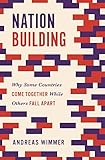Nation Building : Why Some Countries Come Together While Others Fall Apart / Andreas Wimmer.
Material type: TextSeries: Princeton Studies in Global and Comparative SociologyPublisher: Princeton, NJ : Princeton University Press, [2018]Copyright date: ©2018Description: 1 online resource (376 p.) : 18 b/w illus., 44 tablesContent type:
TextSeries: Princeton Studies in Global and Comparative SociologyPublisher: Princeton, NJ : Princeton University Press, [2018]Copyright date: ©2018Description: 1 online resource (376 p.) : 18 b/w illus., 44 tablesContent type: - 9780691177380
- 9781400888894
- 321.09 23
- JC489 .W566 2018
- online - DeGruyter
- Issued also in print.
| Item type | Current library | Call number | URL | Status | Notes | Barcode | |
|---|---|---|---|---|---|---|---|
 eBook
eBook
|
Biblioteca "Angelicum" Pont. Univ. S.Tommaso d'Aquino Nuvola online | online - DeGruyter (Browse shelf(Opens below)) | Online access | Not for loan (Accesso limitato) | Accesso per gli utenti autorizzati / Access for authorized users | (dgr)9781400888894 |
Browsing Biblioteca "Angelicum" Pont. Univ. S.Tommaso d'Aquino shelves, Shelving location: Nuvola online Close shelf browser (Hides shelf browser)

|

|

|

|

|

|

|
||
| online - DeGruyter The Killing Season : A History of the Indonesian Massacres, 1965-66 / | online - DeGruyter The Final Act : The Helsinki Accords and the Transformation of the Cold War / | online - DeGruyter The Art of Being Governed : Everyday Politics in Late Imperial China / | online - DeGruyter Nation Building : Why Some Countries Come Together While Others Fall Apart / | online - DeGruyter Straight Talk on Trade : Ideas for a Sane World Economy / | online - DeGruyter The Fate of Rome : Climate, Disease, and the End of an Empire / | online - DeGruyter Ever the Leader : Selected Writings, 1995-2016 / |
Frontmatter -- Contents -- Figures -- Tables -- A Note to the Reader on the Online Appendix -- Preface -- Acknowledgments -- Introduction -- A Relational Theory and Nested Methods -- Voluntary Organizations: Switzerland versus Belgium -- Public Goods: Botswana versus Somalia -- Communicative Integration: China versus Russia -- Political Integration: Evidence from Countries around the World -- Identifying with the Nation: Evidence from a Global Survey -- Is Diversity Detrimental? -- Policy Implications with Some Lessons Learned from Afghanistan -- Appendix A: Supplement to Chapter 1 (Online) -- Appendix B: Supplement to Chapter 4 -- Appendix C: Supplement to Chapter 5 -- Appendix D: Supplement to Chapter 6 -- Appendix E: Supplement to Chapter 7 -- Appendix F: Supplement to Chapter 8 -- Notes -- References -- Index
restricted access online access with authorization star
http://purl.org/coar/access_right/c_16ec
A new and comprehensive look at the reasons behind successful or failed nation buildingNation Building presents bold new answers to an age-old question. Why is national integration achieved in some diverse countries, while others are destabilized by political inequality between ethnic groups, contentious politics, or even separatism and ethnic war? Traversing centuries and continents from early nineteenth-century Europe and Asia to Africa from the turn of the twenty-first century to today, Andreas Wimmer delves into the slow-moving forces that encourage political alliances to stretch across ethnic divides and build national unity.Using datasets that cover the entire world and three pairs of case studies, Wimmer's theory of nation building focuses on slow-moving, generational processes: the spread of civil society organizations, linguistic assimilation, and the states' capacity to provide public goods. Wimmer contrasts Switzerland and Belgium to demonstrate how the early development of voluntary organizations enhanced nation building; he examines Botswana and Somalia to illustrate how providing public goods can bring diverse political constituencies together; and he shows that the differences between China and Russia indicate how a shared linguistic space may help build political alliances across ethnic boundaries.Wimmer then reveals, based on the statistical analysis of large-scale datasets, that these mechanisms are at work around the world and explain nation building better than competing arguments such as democratic governance or colonial legacies. He also shows that when political alliances crosscut ethnic divides and when most ethnic communities are represented at the highest levels of government, the general populace will identify with the nation and its symbols, further deepening national political integration.Offering a long-term historical perspective and global outlook, Nation Building sheds important new light on the challenges of political integration in diverse countries.
Issued also in print.
Mode of access: Internet via World Wide Web.
In English.
Description based on online resource; title from PDF title page (publisher's Web site, viewed 27. Sep 2021)


